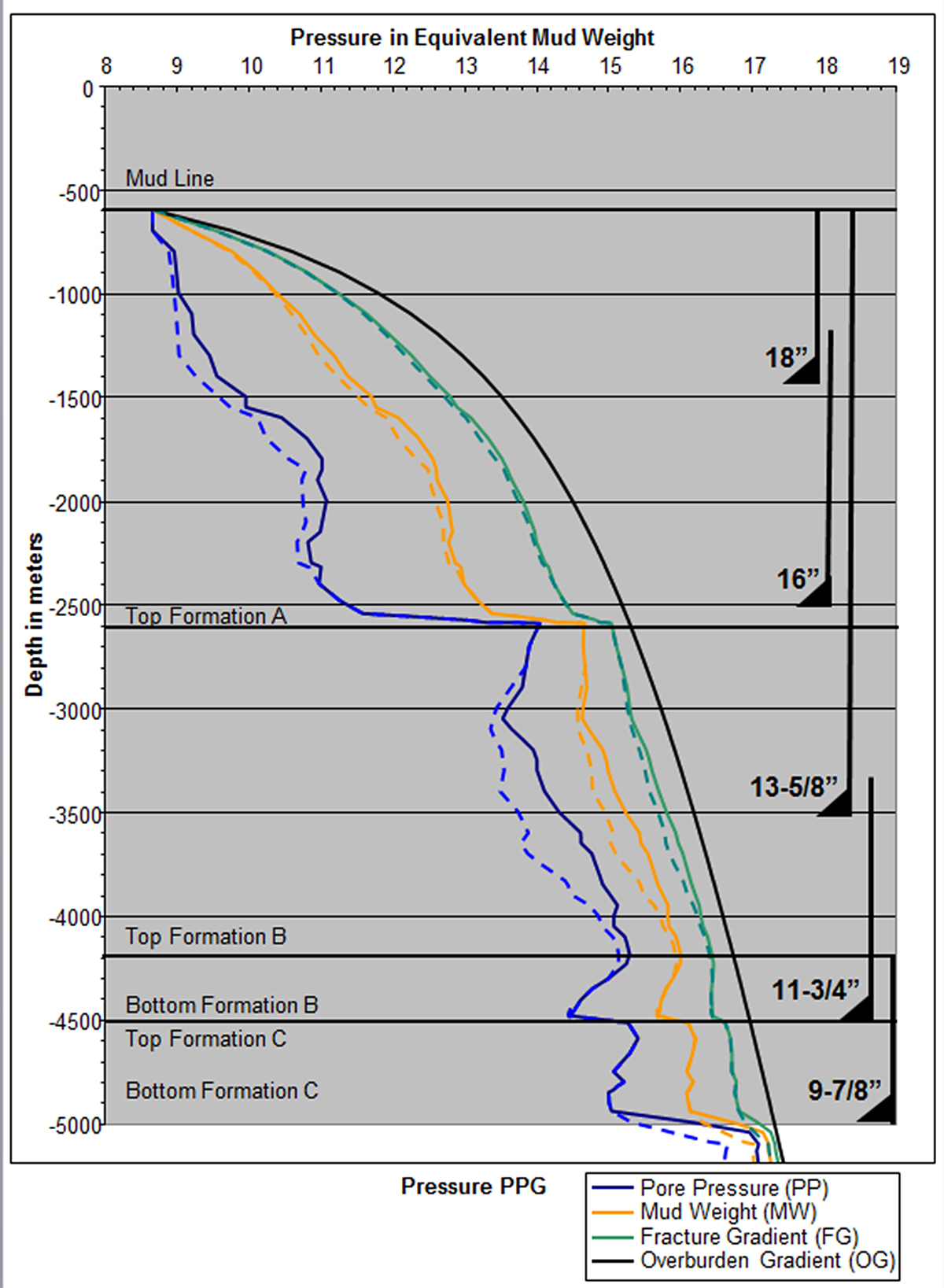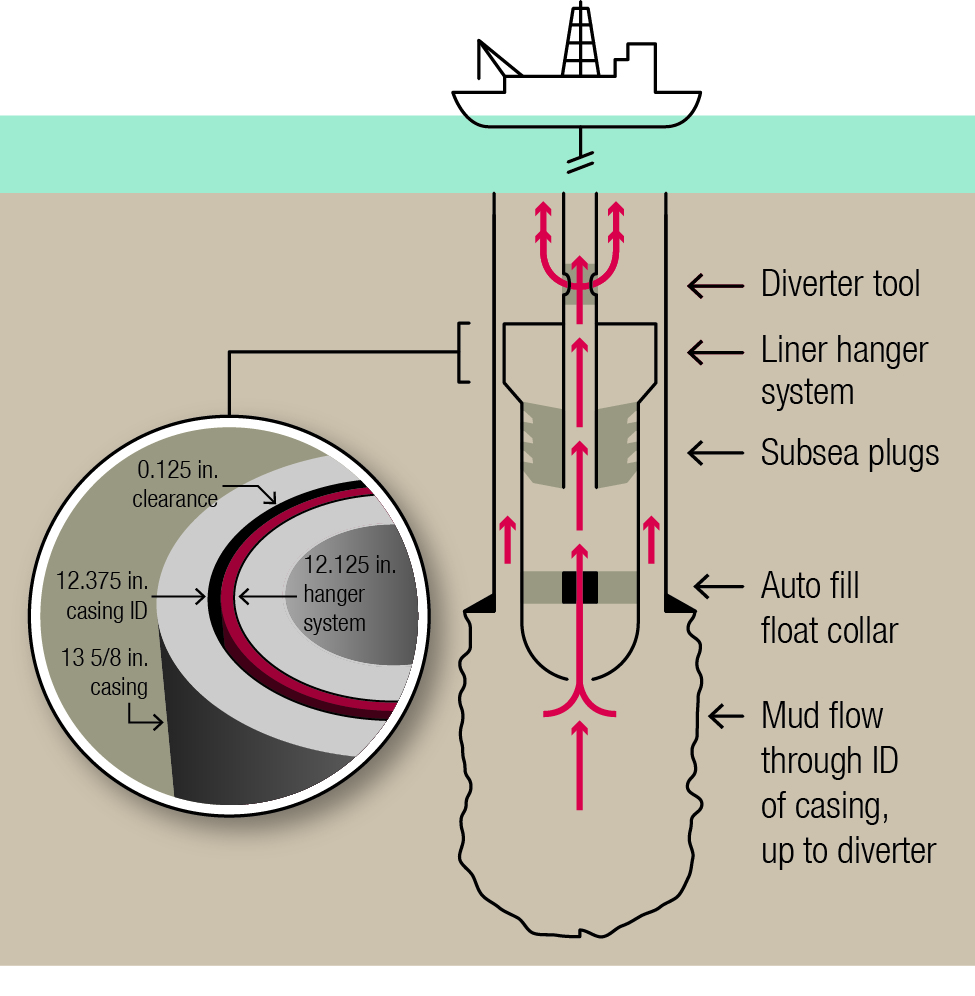The well-known adage “time is money” is applicable to every oilfield operation. For drilling operations in particular, the cost associated with drilling a well is directly related to the time to complete it. Operators, drilling contractors and service companies are constantly looking for better ways to improve the efficiency and safety of drilling and completions operations.
Casing- or liner-running operations are areas that promise major time-saving opportunities. Each string of casing must be run into the hole as quickly as possible but without compromising the integrity of the formation that the casing is designed to isolate. Running too quickly may threaten well integrity in the form of excessive incremental surge or swab pressures. These pressures arise as the pipe runs inside the previous casing string already cemented into place, creating a restrictive annular space and displacing the mud column around the outside of the casing.
If the pressure buildup is too great in this annulus, the mud often has nowhere to go but into the formation. Induced mud losses as a result of exceeding fracture pressures while running casing compromise the success of the primary cement job and contribute to well integrity issues that may require remediation. Losing mud into productive zones can jeopardize future production and limit the reservoir’s full production potential.
In many circumstances, the combined effect of the hydrostatic pressure exerted by the mud column and any additional surge pressure created when tripping casing in the well does not exceed the formation’s fracture gradient. In these cases, conventional float shoes and float collars are installed in the casing string, which divert the displaced mud around the outside of the casing back to surface.
Managing surge in tight windows
In narrow pore-pressure/fracture-gradient margin wells with tight-tolerance annular clearances, however, a more
technically advanced solution may be required to maintain well integrity. An optimized casing running solution—one that ensures both successful deployment of the casing or liner to total depth and a high-integrity primary cement job—should begin with a thorough assessment of any potential well issues before the casing enters the hole.

Software modeling can simulate and predict the potential combined impact of surge pressures and the hydrostatic
pressure of the mud column for a given well’s geometry, fluid properties and geomechanics. Andspecially designed equipment can reduce the surge pressure attributable to running casing and liners on drillpipe by taking returns through the
inside of the casing.
Such a design begins at the bottom of the casing string, where a free-rotating guide shoe allows the casing string to move past wellbore ledges without getting hung up or stuck, a particular risk in highly deviated hole sections. The guide shoe should have an opening with an adequate cross-sectional area to freely permit mud flow into the casing, where an auto-fill float collar
is positioned to allow the mud to flow up the inside of the casing string.
Once the low-margin window section of the formation has been bypassed, the flowing mud will then pass out the top of the casing string through a set of large-bore subsea plugs and a diverter tool, which directs the fluid back up the annular space to the surface.
This casing running scenario efficiently moves 60% to 75% of the mud up the interior of the casing string, reducing the annular pressure and lowering the risk of formation damage and mud losses. Running speeds also can be dramatically improved. Without surge reduction, the operator might elect to run casing at a rate of 1.5 m/min (5 ft/min) or less to reduce the stress to the wellbore, but with surge reduction, running speeds of 6 m/min (20 ft/min) or higher are common.
Surge-reduction success in offshore well
An operator drilling a deepwater exploration well in the U.S. Gulf of Mexico needed a surge reduction solution while running casing strings that were 11¾ in., 14 in., 16 in. and 18 in. in diameter. Such a solution would prevent mud losses while running the casing to its setting depth, circulating the well and cementing the casing in place.
Without it, the operator ran the risk of exceeding the downhole formation fracture gradient. Mud weights ranging from 10.6 pounds per gallon (ppg) for the 18-in. casing to 14 ppg for the 11¾-in. casing were within 0.4 ppg to 0.6 ppg of the fracture gradients, while the equivalent static density and equivalent circulating density were within a 0.05 ppg to 0.1 ppg margin of exceeding the fracture gradient. Poorly executed surge reduction also raised the risks of an inadequate cement job in the
well and an inability to get the casing string deployed to its required setting depth.
Weatherford was tasked with delivering a comprehensive surge-reduction solution for the casing running operation. For each casing size, the solution comprised large-bore auto-fill float collars, large-bore subsea release (SSR) casing wiper plugs and a multi-opening diverter tool. The 16-in., 14-in. and 11¾-in. casing strings also used a plug locator collar and SSR casing wiper plugs with a locator ring on the top plug.
The diverter tool enabled the operator to break circulation without conversion of the auto-fill float equipment while tripping into the well with casing on the landing string, thus reducing mud gel strengths and lowering annular friction pressures at the casing setting depth.

This solution allowed the operator to run thousands of feet of casing without creating surge-induced stresses and without compromising formation integrity. For each casing size deployed, casing-running speeds averaged 7.6 m/min to 10.7 m/min (25 ft/min to 35 ft/min) and eliminated thousands of barrels of potential mud losses while running casing to the planned setting depth.
All casing strings that utilized the SSR plug system and the plug locator collar successfully displaced the entire casing volume and bumped the SSR top wiper plug on the respective float collars. Ultimately, the surge-reduction technology provided the operator with the necessary openhole formation integrity to circulate, condition and execute successfully its primary cementing operations on four close-tolerance casing sizes in narrow margin openhole formations, eliminating the need for subsequent primary cementing remediation.
Effectively managing well integrity includes but is not limited to running casing without losses, being able to circulate full mud returns prior to cementing the well, achieving the required zonal isolation, maximizing reservoir productivity and eliminating the need for remedial cement work later in the life of the well as a result of an inadequate primary cement job.

Recommended Reading
Comments
Add new comment
This conversation is moderated according to Hart Energy community rules. Please read the rules before joining the discussion. If you’re experiencing any technical problems, please contact our customer care team.
